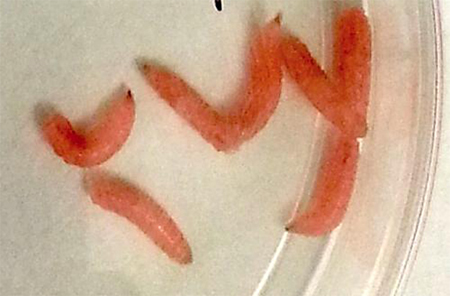
- A-
- A
- A+
Maggots Modified to Heal Wounds Faster
Researchers at North Carolina State University have genetically engineered larvae (i.e. maggots) of the green bottle fly so they secrete human growth factor molecules shown to boost healing.
It may sound icky, but using maggots to promote healing isn’t new — the wormy insects have been placed on wounds for more than a century. The maggots eat dead tissue and leave living tissue alone. The young insects also secrete antimicrobial compounds that help keep the wound clean.
It’s a cheap way to treat wounds, but until now some have doubted the treatment’s effectiveness. Past clinical trials have failed to show that maggots actually speed up a wound’s healing time.
That’s where genetic engineering comes in.
The North Carolina team created two brands of maggots — one was engineered to produce human platelet derived growth factor-BB when the maggots were warmed to 37 degrees Celsius (98.6° F). The second group was designed to release the growth factor when their diet lacked a specific antibiotic.
The lab results showed the first group did not end up releasing adequate amounts of the healing growth factor, but the second group with the antibiotic-limited diet did.
The next step is to test the modified maggots in clinical trials.
While placing maggots on a wound may sound gross, it holds out particular promise for Diabetes patients who often suffer from long-lasting ulcers on their legs and feet.
“A vast majority of people with diabetes live in low- or middle-income countries, with less access to expensive treatment options,” said author Max Scott, an NC State professor of entomology in a press release. Scott said the engineered maggots could offer “a cost-effective means for wound treatment that could save people from amputation and other harmful effects of diabetes.”
Similar News
Links



 Elm TV
Elm TV
 Photo
Photo
 Video
Video





